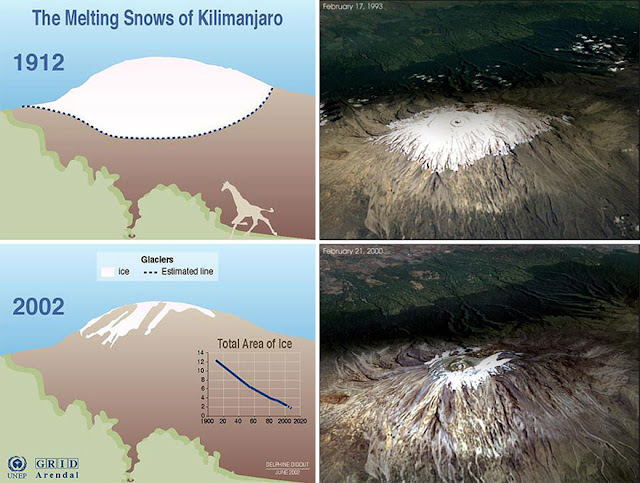Kilimanjaro Snow Cap Melting
The volcano of Kilimanjaro lies in the north-east of Tanzania, in the vast plains. The highest point of the continent (5895 m above sea level) has become a symbol of climate change. The snow cap, which covered the summit of Kilimanjaro 11,000 years since the last Ice Age, is melting quickly. Climatologists have concluded that over the last decades the melting of ice on Kilimanjaro has accelerated. From 1912 to 1953 the area of the ice shield was reduced by 1.1% per year. From 1953 to 1989, this indicator rose to 1.4%, and from 1989 to 2007 it reached 2.4%. Now the researchers predict that in case the current trend persists, by 2033 the highest mountain will have lost its snow cap altogether.
High dryness in East Africa is deemed to be the main reason of glacier shrinkage and it may be speeding up owing to global climate change. Another driver of local climate change on Kilimanjaro is deforestation. Although recent researches show that this affects only lower elevations. This is indeed serious for millions of people depending upon the rich vegetation on green slopes of Kilimanjaro, but studies of this effect have not found any strong evidence that this is affecting the glaciers.
Experts arrive at the conclusion that the vanishing of glaciers is fraught with a global humanitarian catastrophe, the first victims of which might be the residents of Tanzania and other lands of the African Continent who would receive water from Kilimanjaro. The Chaga people use a series of canals and water diversion to irrigate their farms. The folk is already seeing the sinking of the wells. Here, the mountain supports a million people. In case of drought, they will have no more water for irrigation. Fruits, vegetables, and even animals will not have enough water.
The white cap of Kilimanjaro has always been considered an integral part of the unique landscape of Tanzania which attracted thousands of tourists from all over the world to have an unforgettable experience of a Kilimanjaro climb. However, the glacier that is under the threat of disappearance was not only the object of interest of tourists, but also a natural reserve of freshwater.
Also read about how the cost of climbing Kilimanjaro is formed.
Scientists still debate the cause of this situation: deforestation or climate change. But one or the other, 85% of the ice has melted in the last 100 years. As clouds, ice and streams disappear, it is life on the ground that will suffer the worst consequences.
It is painful and scary to acknowledge that soon Snows of Kilimanjaro will exist only as a memory and the title of a short story written by Ernest Hemingway.
Source: https://tunza.eco-generation.org/worldReportView.jsp?viewID=44027



Comments
Post a Comment